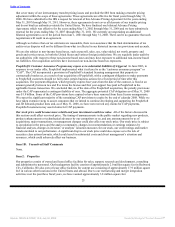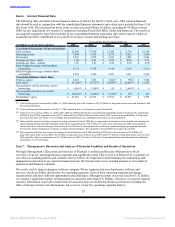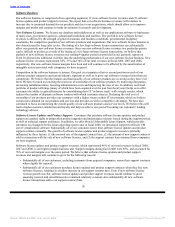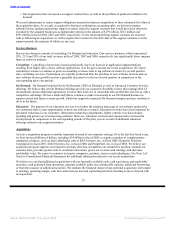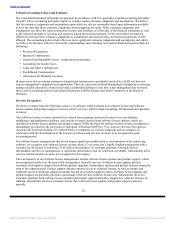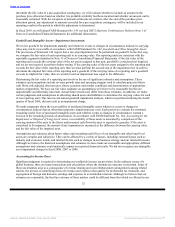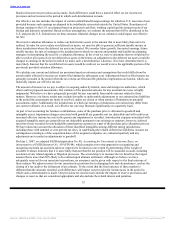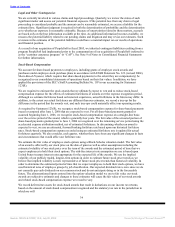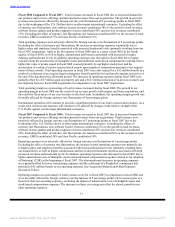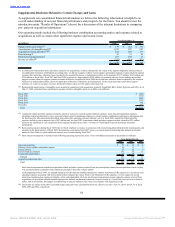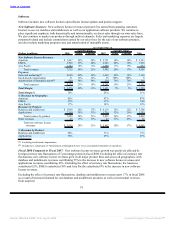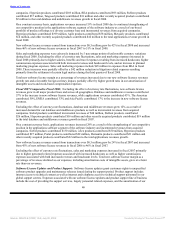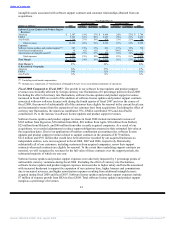Oracle 2007 Annual Report Download - page 36
Download and view the complete annual report
Please find page 36 of the 2007 Oracle annual report below. You can navigate through the pages in the report by either clicking on the pages listed below, or by using the keyword search tool below to find specific information within the annual report.
Table of Contents
Although we believe the assumptions and estimates we have made in the past have been reasonable and
appropriate, they are based in part on historical experience and information obtained from the management of
the acquired companies and are inherently uncertain. Examples of critical estimates in valuing certain of the
intangible assets we have acquired or may acquire in the future include but are not limited to:
• future expected cash flows from software license sales, support agreements, consulting contracts, other
customer contracts and acquired developed technologies and patents;
• expected costs to develop the in-process research and development into commercially viable products
and estimated cash flows from the projects when completed;
• the acquired company’s brand and competitive position, as well as assumptions about the period of
time the acquired brand will continue to be used in the combined company’s product portfolio; and
• discount rates.
Unanticipated events and circumstances may occur which may affect the accuracy or validity of such
assumptions, estimates or actual results.
In connection with the purchase price allocations for our acquisitions, we estimate the fair value of the
support obligations assumed. The estimated fair value of the support obligations is determined utilizing a cost
build-up approach. The cost build-up approach determines fair value by estimating the costs related to
fulfilling the obligations plus a normal profit margin. The estimated costs to fulfill the support obligations are
based on the historical direct costs related to providing the support services and to correct any errors in the
software products acquired. The sum of these costs and operating profit approximates, in theory, the amount
that we would be required to pay a third party to assume the support obligation. We do not include any costs
associated with selling efforts or research and development or the related fulfillment margins on these costs.
Profit associated with any selling efforts is excluded because the acquired entities would have concluded
those selling efforts on the support contracts prior to the acquisition date. We also do not include the
estimated research and development costs in our fair value determinations, as these costs are not deemed to
represent a legal obligation at the time of acquisition.
As a result, we did not recognize software license updates and product support revenues related to support
contracts in the amounts of $179 million, $212 million and $391 million that would have been otherwise
recorded by the acquired businesses as independent entities in fiscal 2008, 2007 and 2006, respectively.
Historically, substantially all of our customers, including customers from acquired companies, renew their
contracts when the contracts are eligible for renewal. To the extent these underlying support contracts are
renewed, we will recognize the revenues for the full value of the support contracts over the support periods,
the substantial majority of which are one year.
Had we included costs for our estimated selling and research and development activities and the associated
margin for unspecified product upgrades and enhancements to be provided under our assumed support
arrangements, the fair values of the support obligations would have been significantly higher than what we
had recorded and we would have recorded a higher amount of software license updates and product support
revenues both historically and in future periods related to these assumed support arrangements.
Other significant estimates associated with the accounting for business combinations include restructuring
costs. Restructuring costs are typically comprised of severance costs, costs of consolidating duplicate
facilities and contract termination costs. Restructuring expenses are based upon plans that have been
committed to by management, but are generally subject to refinement during the purchase price allocation
period (generally within one year of the acquisition date). To estimate restructuring expenses, management
utilizes assumptions of the number of employees that would be involuntarily terminated and of future costs to
operate and eventually vacate duplicate facilities. Estimated restructuring expenses may change as
management executes the approved plan. Decreases to the cost estimates of executing the currently approved
plans associated with pre-merger activities of the companies we acquire are recorded as an adjustment to
goodwill indefinitely, whereas increases to the estimates are recorded as an adjustment to goodwill during the
purchase price allocation period and as operating expenses thereafter.
For a given acquisition, we may identify certain pre-acquisition contingencies. If, during the purchase price
allocation period, we are able to determine the fair value of a pre-acquisition contingency, we will include
that amount in the purchase price allocation. If, as of the end of the purchase price allocation period, we are
unable to
31
Source: ORACLE CORP, 10-K, July 02, 2008 Powered by Morningstar® Document Research℠


